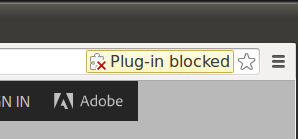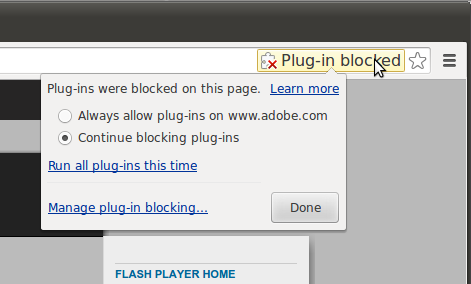NPAPI deprecation: developer guide
We recently updated our plans to phase out support for NPAPI in early 2015. This guide provides more details about what to expect and alternatives to NPAPI.
Timeline
January 2014
Starting in Chrome 32*—expected to reach the Stable channel in mid-January 2014—*when a user visits a page with a blocked NPAPI plug-in, they will see:
Note that users who have already installed the plug-in in previous versions of Chrome will still need to go through this "click-to-accept" experience. You can test the behavior on this site.
Mid-2014
In mid-2014, the blocking UI will become more difficult to navigate, as a means of discouraging NPAPI use by developers. With the harder-to-bypass blocking UI, users will see a puzzle piece in place of the plug-in and a "Blocked plug-in" page action icon in the Omnibox:
| Puzzle piece with right-click context menu | Blocked plug-in page action | ||
| (The yellow box will animate in.) |  |
 |
Right clicking the puzzle piece will bring up a context menu allowing the
user to run or hide the plug-in (just once).
Left clicking the page action icon will bring up a bubble giving the user
the choice to "Always allow plug-ins on this site" or "Run all plug-ins this
time."
Note that there will not be a yellow info bar (i.e. "drape") at the top of the page. Also, the page action icon will appear even if the plug-in itself is invisible. Visit this site in Canary to see the new UI in action: http://www.medicalrounds.com/quicktimecheck/troubleshooting.html
This behavior is similar to existing behavior when all plug-ins are blocked by default (“Settings” => “Advanced Settings” => “Privacy - Content Settings” => “Plug-ins,” select “Block all,” and then load, for example, http://techcrunch.com).
January 2015
Currently Chrome supports NPAPI plugins, but they are blocked by default unless the user chooses to allow them for specific sites (via the page action UI). A small number of the most popular plugins are allowed by default. In January 2015 all plugins will be blocked by default. Even though users will be able to let NPAPI plug-ins run by default in January, we encourage developers to migrate of off NPAPI as soon as possible. Support for NPAPI will be completely removed from Chrome by September 2015.
April 2015
In April 2015 (Chrome 42) NPAPI support will be disabled by default in Chrome and we will unpublish extensions requiring NPAPI plugins from the Chrome Web Store. All NPAPI plugins will appear as if they are not installed, as they will not appear in the navigator.plugins list nor will they be instantiated (even as a placeholder). Although plugin vendors are working hard to move to alternate technologies, a small number of users still rely on plugins that haven’t completed the transition yet. We will provide an override for advanced users (via chrome://flags/#enable-npapi) and enterprises (via Enterprise Policy) to temporarily re-enable NPAPI (via the page action UI) while they wait for mission-critical plugins to make the transition. In addition, setting any of the plugin Enterprise policies (e.g. EnabledPlugins, PluginsAllowedForUrls) will temporarily re-enable NPAPI.
September 2015
In September 2015 (Chrome 45) we will remove the override and NPAPI support will be permanently removed from Chrome. Installed extensions that require NPAPI plugins will no longer be able to load those plugins.
Exceptions
The only allowed plug-ins are the ones mentioned in the blog post. That list is based entirely on usage. There is no "process" for other plug-ins to be universally allowed and the list will be removed in January 2015.
Enterprise
Enterprise administrators will be able to allow specific NPAPI plug-ins by adding them to the EnabledPlugins policy list, to avoid their users seeing the UI mentioned above. Setting this policy also re-enables NPAPI plugins. This, however, will not be relevant once support for NPAPI is completely removed from Chrome in September 2015. Hence we recommend enterprises and enterprise app developers as well to move entirely off NPAPI as soon as possible.
On Mac, version 39 onward, Chrome will be 64 bit only and this will imply 32 bit NPAPI plugins will stop to work on Chrome on Mac and there will be no way to allow it by policy. 64 bit plugins however can still be allowed and will continue to work until overall NPAPI removal in September 2015.
Alternatives to NPAPI
With the deprecation of NPAPI, some developers have asked which modern technologies can be used to implement features which in the past would have relied on a platform-specific NPAPI plug-in. In answer to these questions we have composed the following list of common NPAPI use cases and web platform alternatives.
In general, the core standards-based web technologies (HTML/CSS/JS) are suitable for most client software development. If your application requires access to features outside the web sandbox, myriad Chrome Extension and App APIs offer access to OS features.
Video and audio
A common use case for NPAPI plug-ins on the modern web is embedded video and/or audio. A range of modern web technologies exist to facilitate media streaming. The basic building blocks are WebRTC and media elements:
HTML5 Media Elements. The [HTML5 Specification](https://www.w3.org/TR/html5/)
provides a rich media platform through the
[<audio>](https://www.w3.org/TR/html5/embedded-content-0.html#the-audio-element)
and
[<video>](https://www.w3.org/TR/html5/embedded-content-0.html#the-video-element)
elements. More complicated use cases can be achieved using the
[<canvas>](https://www.w3.org/TR/html5/embedded-content-0.html#the-canvas-element)
element (for example check out the [Video FX Chrome
Experiment](http://www.chromeexperiments.com/detail/videofx/)).
WebRTC. [WebRTC](http://dev.w3.org/2011/webrtc/editor/webrtc.html) was
designed for real time communication between peers and the technology can
also be used for applications like live streaming media and data. Google’s
[Chromecast
device](https://www.google.com/intl/en/chrome/devices/chromecast/) uses
WebRTC to stream HD video between a browser and TV.
Several features on top of these building blocks support more advanced use cases:
Adaptive Streaming
The ability to adapt media streaming to an individual consumer is critical in delivering high-quality content to a large audience. In the past this capability has been provided by technologies such as Silverlight’s smooth streaming and Quicktime’s HTTP live streaming. The Media Source Extensions to the HTML media element provide the capability to adapt a stream to an individual consumer on the modern web. Html5rocks has put together a great example of how to use the Media Source Extensions to implement some of these common use cases.
Video Conferencing
Several of the most popular NPAPI extensions including Facebook Video Chat and Google Talk provide video conferencing functionality within the browser. With the introduction of WebRTC video conferencing is facilitated directly through JavaScript APIs. The Cube Slam Chrome Experiment provides an example of peer to peer video conferencing via WebRTC.
Digital Rights Management
Encrypted Media Extensions give HTML5 video the DRM capabilities that previously would have required the use of a platform specific plug-in. The WebM project has provided a demo which performs video playback using the Encrypted Media Extensions of the video element. For more information, check out the EME HTML5 Rocks article.
Closed Captioning
WebVTT and the <track> element (a child element of <video>) enable web developers to add timed-text captioning capabilities to their HTML apps.
Communicating with native applications
Try the Native Messaging API for Chrome Apps and Extensions.
Games & 3D
Native Client (NaCL) provides a rich environment for cross-platform game development. Many games have already been ported to or designed for NaCL. A number of examples and detailed tutorials to get started with NaCL are available on the NaCL development site. The WebGL specification provides a high-performance platform for hardware-accelerated 3D graphics in the browser. Chrome experiments has an entire category dedicated to examples and demos of various WebGL use cases.
Security
Some services have relied on NPAPI-based security techniques. We recommend switching to TLS or, soon, Web Crypto.
Hardware access
In the past it has often been necessary to write platform specific plug-ins to access system hardware such as webcams, microphones, USB devices, and bluetooth. Direct access to local media streams such as webcams and microphones can now be requested directly from the web via the WebRTC Media Capture specification. Chromium also provides an App API for access to USB hardware and another API for accessing Bluetooth devices.
Screen capture
Chrome extensions can perform screen capture or streaming using either Desktop Capture for full screen capture or the Tabs API captureVisibleTab for individual tab content capture.
